Invisalign – Federal Way, MA
A Discreet, Comfortable, Convenient Alternative to Braces
Years prior, patients struggling with crooked or spaced-out teeth had one option: metal orthodontics. While certainly effective, they left much to be desired in the looks department. Thankfully, patients today can opt for a discreet, comfortable, convenient alternative to braces, Invisalign! Dr. Drew Beaty is a preferred Invisalign provider who has helped countless patients achieve the perfectly straight smile of their dreams. If you’re interested in this popular teeth-straightening service, keep reading or contact our team !
Why Choose Drew Beaty, DDS Family and Cosmetic Dentistry for Invisalign?
- Preferred Invisalign Provider
- Multiple Financing Options
- Morning, Evening & Lunchtime Appointments
How Invisalign Works
While the technology behind Invisalign in Federal Way is complex, the process itself is straightforward enough. Basically, throughout your treatment timeline, you’ll be given multiple sets of aligners, which you will wear for a few weeks at a time. Each one will exert just enough pressure to slowly (and safely!) guide your teeth into their new and improved positions. Then, the next pair will pick up where the last one left off. After working through the entire series of aligners, your teeth will be perfectly straight.
Who Can Invisalign Help?
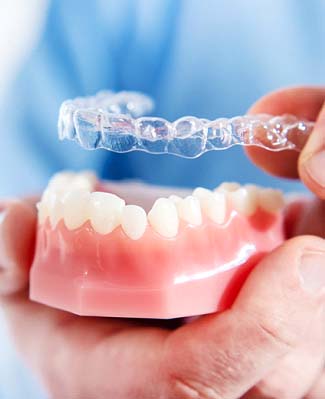
To achieve a straighter and healthier smile, Invisalign may be the ideal solution for you. This process is usually quicker than traditional braces and the discreet trays will allow you to enjoy showing off your bite throughout your treatment. While Invisalign is not designed to address more complex orthodontic issues, like severely rotated teeth, it can certainly correct a wide range of common complications.
Crowded Teeth
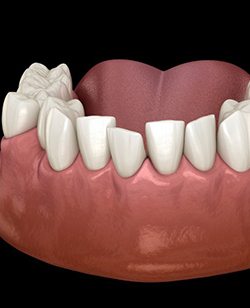
Teeth that are overlapping can negatively impact both the look and function of your smile. Luckily, Invisalign’s discreet aligners are up for the job! The pressure from the trays can address crooked teeth, moving them into proper alignment without drawing unwanted attention to your smile.
Gaps Between Teeth
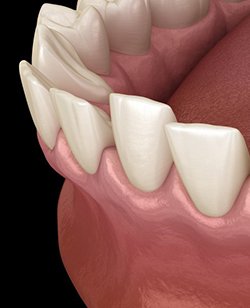
Spaced-out teeth are another orthodontic issue that can take a toll on the appearance and health of your smile. The good news is that Invisalign can bridge the gaps, guiding your teeth into a more aesthetically pleasing, functional position.
Overbite

When the upper teeth protrude too far away from the bottom set, this is known as an overbite. This condition can lead to various issues such as uneven enamel wear, speech difficulties, jaw pain, and trouble closing/opening the mouth. The top arch can also become more susceptible to damage or injury, as they won’t be properly supported by the lower teeth. Invisalign can help correct the issue by moving the lower jaw to a more comfortable and healthier position.
Underbite
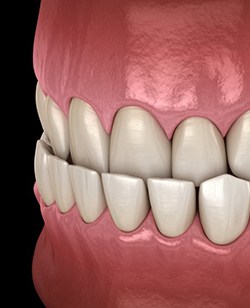
The bottom teeth can sometimes jut out too far from the upper row, creating what’s known as an underbite. The cause for this can range from jaw injury or genetics to non-nutritive habits, such as thumb-sucking or using a pacifier after a certain age. If left untreated, it can result in issues with speaking and chewing, mouth breathing, and a higher risk of sleep apnea. By using Invisalign and elastic bands, you can gradually retrain your lower jaw to sit in its proper place.
Crossbite
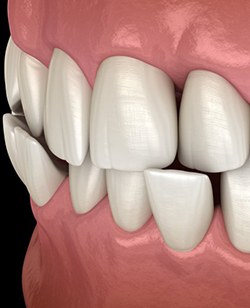
A crossbite is when some of the lower teeth sit slightly in front of the top teeth. This misalignment problem can occur due to poor oral habits, genetics, and premature loss of baby teeth. If left unchecked, you can end up experiencing an increased risk of dental decay, gum disease, difficulty speaking, teeth grinding, jaw discomfort, headaches, and facial asymmetry. With Invisalign, we can shift both your upper and lower teeth so that they sit perfectly aligned with each other, minimizing your chance of developing the above complications.
Open Bite
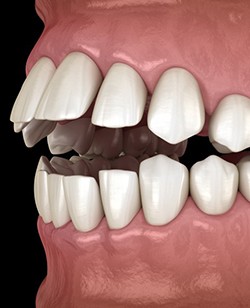
If you notice that your front teeth refuse to come into contact when biting down, then you have an open bite. This can typically be caused by non-nutritive habits, like thumb-sucking, or poor bone development. Not only can this make it difficult to chew properly or speak comfortably, but you can also end up wearing down the enamel of your rear teeth. Invisalign, along with other oral accessories, can help address this bite pattern so you can reduce your risk of damage.
Benefits of Invisalign
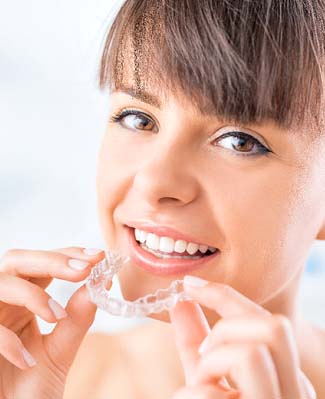
Have you ever wondered why more than 12 million patients have chosen Invisalign? Well, there isn’t just one reason; there are several! In this next section, we’re covering why clear aligner treatment has been (and continues to be) so popular each year.
No Dietary Restrictions

Whole apples, tortilla chips, and hard pretzels are just a few of the many foods patients with traditional braces are asked to avoid. The same does not apply to patients with Invisalign since the aligners are removable! Of course, it’s still a good idea to exercise caution with extremely crunchy foods since they can cause one of your attachments to come off. We also recommend continuing to keep your consumption of added sugar to a minimum to help keep your teeth and gums healthy.
Simple Oral Hygiene

Another considerable perk with Invisalign is that you don’t need to adopt a cumbersome oral hygiene regimen that includes interproximal toothbrushes and other special dental care products. Instead, you can take off your aligners, place them somewhere safe, and continue to brush and floss as normal! The one adjustment that you’ll need to make in this department is doing so after each meal; it’s crucial to keeping your smile healthy and your aligners clear.
Fewer Appointments

Usually, patients with traditional braces have an adjustment appointment every four weeks. As you can imagine, these visits can fill up your calendar quite quickly! The good news is that Invisalign visits are a bit more spaced out (usually every six to eight weeks). That means less time in our treatment chair and more time doing what you want.
Quicker Average Treatment Timeline

You want to see the results of all of the time and money you invested as quickly as possible, right? You’ll be happy to hear that Invisalign has quicker treatment timelines on average. While traditional braces can take 24 months or more, clear aligner treatment is usually between 12 and 18 months. Just make sure to follow all of the guidelines we provide you with so you don’t fall off-track!
Discreet Aligners

It’s common for patients with traditional braces to feel self-conscious smiling. In fact, they often develop a habit of keeping their lips closed when they smile so attention isn’t drawn to the metal brackets and wires. Invisalign, on the other hand, guides your teeth into their properly aligned positions with see-through aligners that are virtually undetectable when worn. So, you’ll be able to smile confidently throughout your entire teeth-straightening journey!
Living with Invisalign Aligners

Patients have all sorts of questions for us at their consultation, and we’re happy to answer them all! One of the most common ones is, “What is life with Invisalign actually like?” If you’ve been asking yourself that same question (and you want to learn the answer before your appointment), then keep reading!
Wearing Your Trays

As you may have guessed, one of the biggest adjustments will be actually wearing your trays. In order to stay on track with your treatment plan, you need to wear them for 20-22 hours a day. This may seem like plenty of time to eat and brush your teeth throughout the day, but it goes by quickly, especially at the beginning of your treatment when it takes some time taking your trays off and putting them back on. That’s why we recommend using the stopwatch on your phone until you have a solid routine in place.
Cleaning Your Aligners
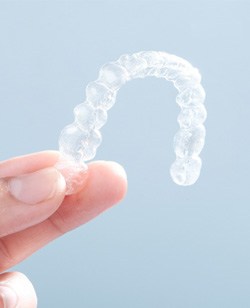
One of the best parts of Invisalign is that you don’t need to buy special oral hygiene products, like interproximal toothbrushes. In fact, you really only need two things to keep your trays clean: water and a soft-bristled toothbrush. After thoroughly rinsing your aligners in clean, cool water, use the bristles of your toothbrush to gently scrub each surface. You can also use a mixture of the cleaning crystals that came in your welcome kit and some lukewarm water to give your aligners an even deeper clean.
Eating & Drinking

Although Invisalign doesn’t come with any dietary restrictions, there are a few things you need to know about eating and drinking with clear aligners. Perhaps the most important is that you must take them out if you’re consuming anything other than water. If you don’t, then they can stain, warp, and even crack in half. Of course, as your dental team, we still recommend keeping your consumption of starchy and sugary items to a minimum since they increase your risk of developing tooth decay.
Losing or Damaging a Tray

Losing or damaging a tray can be stressful, which is why we recommend calling us ASAP. Once we know a bit more about what happened and see where you are in your treatment plan, we can determine if you can move onto the next set of aligners a bit early. If that’s not an option, then we will ask you to wear your previous set of trays until the replacement ones arrive.
Tip: One of the easiest ways to avoid losing or damaging your aligners is by placing them in their designated case anytime you aren’t wearing them.
Routine Check-Ins

With traditional braces, patients need to come in for adjustment appointments every four weeks. With Invisalign, you only need to come in every six or eight weeks, and the visits are usually only 15 minutes or so. At this time, we will take new scans of your teeth so we can monitor their movement. If they aren’t moving as anticipated, we can make some recommendations and small adjustments to your treatment plan to help prevent considerable delays.
How Much Does Invisalign Cost?
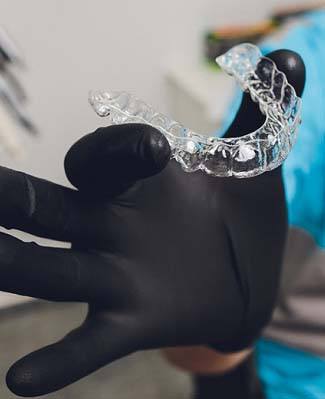
The cost of Invisalign will be determined at your initial consultation. That’s because factors like the severity of your orthodontic issues and how many trays you need have to be considered. Don’t fret though – our dentist in Federal Way will provide you with a price estimate upfront so you have an accurate number in mind. From there, we can review all of the different financial options, from flexible financing to our special offers.
Factors That Affect the Cost of Invisalign

- The estimated length of time that your treatment will take (the more time required, the more aligners you’ll need to pay for)
- Whether you wear the aligners as often as directed (failure to wear them often enough causes your teeth to shift more slowly, extending your treatment)
- The specific type of orthodontic issue you have as well as its severity
- Whether you’ll need to wear aligners on your upper arch, lower arch, or both
Everyone’s smile is unique, so each patient will require a slightly different treatment in order to bring their smile into the proper alignment. When you visit us for a consultation, our team will discuss the variables that can affect the cost of Invisalign in Federal Way, which include:
Invisalign vs. Smile Direct Club™: How Do the Costs Compare?
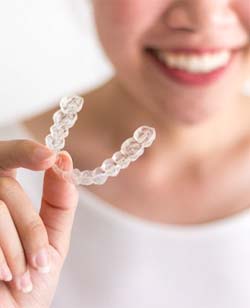
At first glance, Smile Direct Club and other mail-order clear aligners seem like the more affordable option. On average, they cost only a fraction of what Invisalign does. However, there’s a good reason why Invisalign has a higher price; it’s a safer and more effective solution.
With Invisalign, you’ll be guided by a trusted dental professional every step of the way. Smile Direct Club, on the other hand, requires you to complete your treatment on your own. It’s all too easy for several problems to develop, from taking incorrect impressions to not wearing the aligners properly. Your teeth might end up moving in different ways than they’re supposed to, causing you to spend more money getting them fixed by a dentist later on.
You’re better off investing in Invisalign from the start. It may cost a bit more initially, but you can’t put a price on the peace of mind and safe results it will bring!
Does Dental Insurance Cover Invisalign?
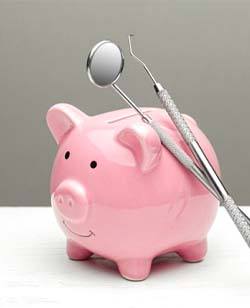
The amount of Invisalign coverage that dental insurance companies offer can vary greatly. Many providers tend to exclude Invisalign, but that’s not necessarily the case. For this reason, we recommend contacting your insurance provider directly to find out whether they’ll cover any of your treatment costs. Our team is also happy to help with this process; we’re even in-network with Delta Dental , Premera, Regence, and many other leading dental insurance companies.
Options for Making Invisalign Affordable

Aside from dental insurance, we have other ways of providing affordable Invisalign in Federal Way. For one, we’ve partnered with CareCredit, a third-party financier that lets qualified patients split up their treatment costs into low-interest monthly payments.
We also have our own in-house dental savings plan as an alternative to insurance. All you have to do is pay a flat annual fee to access two free exams and cleanings per year, a discount on all of our treatments (including some that insurance won’t cover), and $250 off of Invisalign. It’s a great way to make not only your Invisalign treatment affordable, but also routine preventive care for the whole family!
Invisalign FAQs
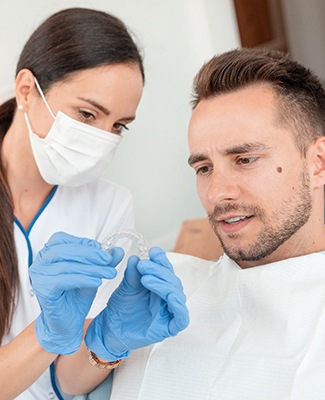
Invisalign is an excellent teeth straightening option that can give you beautiful results without the need for metal brackets and wires, but you may still have some unanswered questions. Here are the answers to some of the most common Invisalign questions we receive. If you don’t see the information that you’re looking for below, don’t worry! Give us a call and we’d be happy to answer any questions you have and get you started with an initial consultation.
Does Invisalign Hurt?
Invisalign is not a painful treatment. Its smooth plastic design makes it one of the most comfortable orthodontic treatment options out there. When you first get Invisalign, there will be an adjustment period where you may experience some soreness, but this will go away as you get used to the treatment. Invisalign works by gradually shifting your teeth into proper alignment by using a series of aligners. Each time you switch to the next aligner, you may feel some pressure, but this just means that the treatment is working. To minimize any discomfort you’re feeling, try taking over-the-counter pain relievers or using a cold compress.
Can You Eat with Invisalign?
One of the main advantages of Invisalign is that they are completely removable, so you can take out your aligners when mealtime comes around. Eating with your Invisalign will not only damage your aligners, causing cracks and stains, but it also puts unnecessary pressure on your teeth. The only thing you should be consuming while wearing your Invisalign is water.
Can You Get Invisalign After Braces?
This all depends on your specific needs. Braces are able to correct more severe overbites, underbites, and crossbites than Invisalign can, so some patients need to opt for the traditional method. If your teeth have grown crooked or misaligned years after you completed treatment with braces, Invisalign can usually help. During your initial consultation, we will take a look at your smile to see if Invisalign is the right method for you.
Does Invisalign Give You a Lisp?
Just like any addition to your smile, there will be an initial adjustment period when it comes to your speech. Lisps are caused by improper tongue placement inside the mouth when you speak, which affects airflow and can make some words sound different. In some cases, patients will develop a lisp when they first get Invisalign, but most are unaffected. If you do end up with a slight lisp, don’t worry. It usually is very minor and will go away on its own once you get used to your aligners. The more you talk, the quicker your tongue will learn how to maneuver with Invisalign.
How Long Does Invisalign Take?
While traditional braces can take 24+ months, Invisalign’s average treatment is just 12 to 18 months! Naturally, your timeline will depend on factors specific to you, such as the severity of your misalignment and how many aligners you need. Something else to consider is the wear time. Since traditional braces are bonded to your teeth, the brackets and wires are constantly working to move your teeth. With Invisalign, you need to make a conscious effort to wear the aligners for 20+ hours a day so your teeth track properly.
Can I Drink Coffee with Invisalign?
You can’t drink coffee with your aligners in. You can drink coffee once you remove them, though! We encourage our patients to enjoy this caffeinated beverage with their meals since the trays will already be out. Of course, there are a few additional best practices we recommend, like using a straw to prevent discoloration, brushing your teeth 20 minutes later to prevent enamel erosion, and not adding sugar to prevent cavities.
How Do I Clean My Aligners?
There are a few measures we recommend taking to keep your aligners clean, starting with rinsing them with clean, lukewarm water each time you remove them. After each meal, you should also use a soft-bristled toothbrush and toothpaste to clean each surface. Lastly, make sure you aren’t eating or drinking anything other than water with your aligners in since this can quickly cause them to discolor.
Note: if you need to give your aligners a deeper clean, you can also use the cleaning crystals that came in your Invisalign welcome kit!
Why Do I Have to Wear My Aligners for 20+ Hours a Day?
The short answer is that your aligners only work to move your teeth while you’re wearing them! As a result, the more you wear them, the more likely you are to get the results you desire. That’s why patients are encouraged to only take them out when eating, drinking anything other than water, and completing their oral hygiene regimen. Removing them too frequently can negatively impact your treatment plan by adding weeks or even months to your timeline.
What Happens After Invisalign?
Once you’ve worked through your entire series of trays (as well as any refinement trays), your time with Invisalign will officially be complete! With that said, there is another important step of the process: wearing your retainer. Basically, this orthodontic device makes sure that your teeth don’t move out of position (a phenomenon known as “orthodontic relapse”). Usually, patients are encouraged to make wearing it each evening a lifelong best practice.
What Do I Do If I Break an Aligner?
As we covered in some of the previous questions, meeting the 20-22 hour-a-day wear time is crucial. Once you break your aligners, the clock starts ticking, so call our Federal Way dental team ASAP. Once we have a better understanding of your situation and where you are in your treatment timeline, we can determine what to do next. For example, some patients are asked to wear their previous tray until a replacement one arrives while others are instructed to simply move onto the next aligner in the series.
